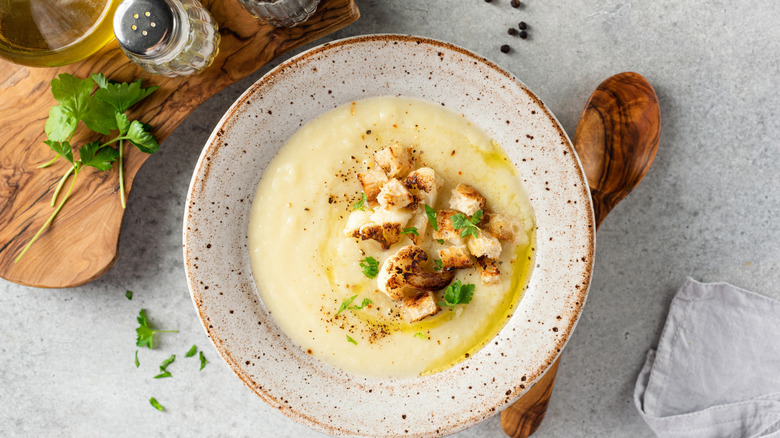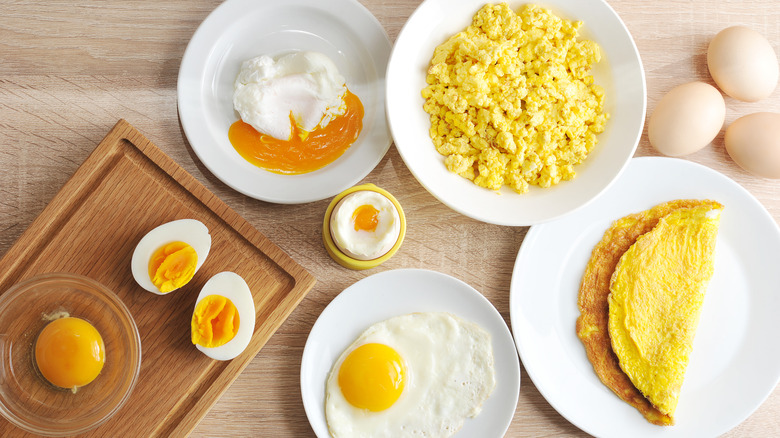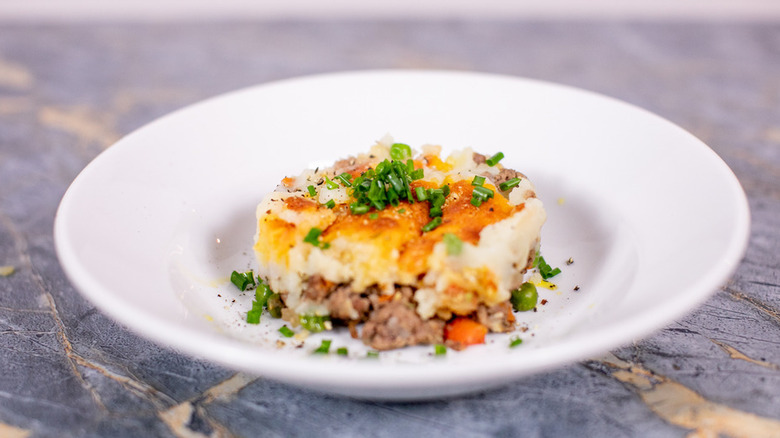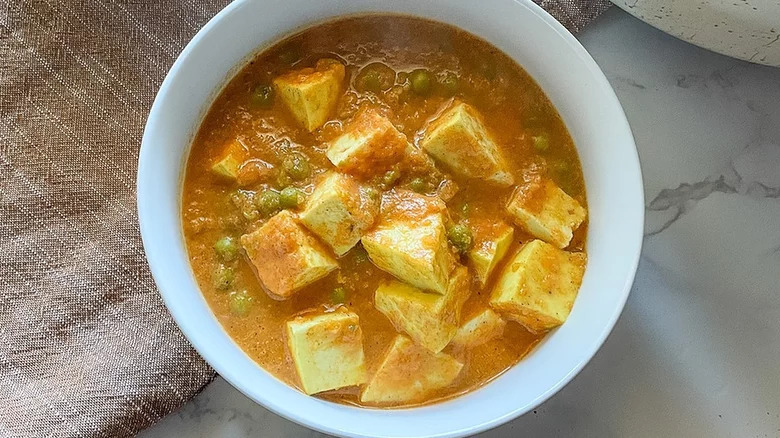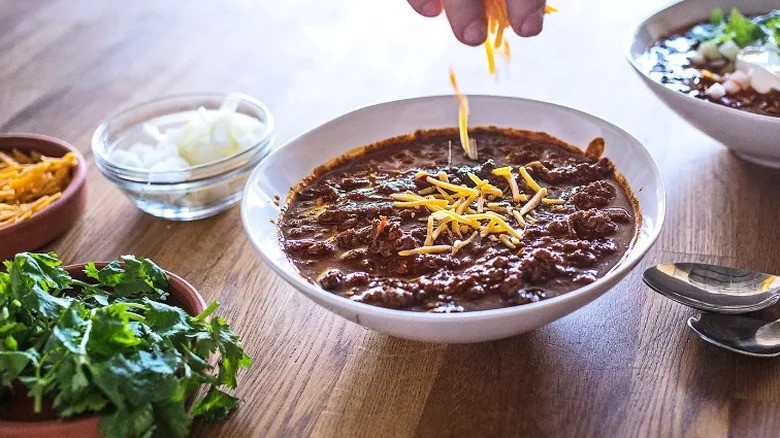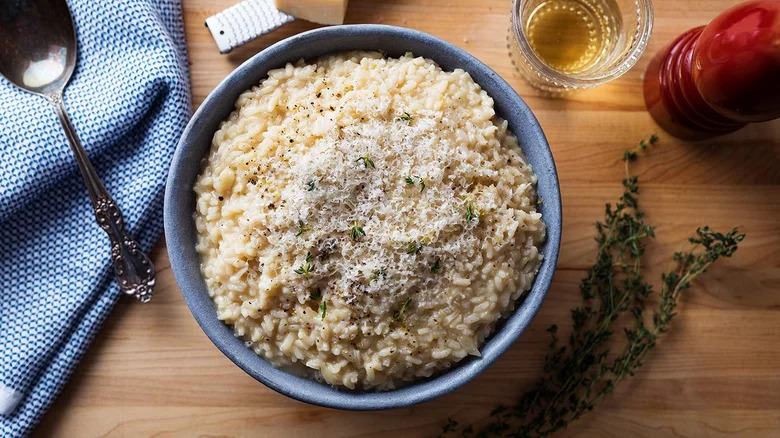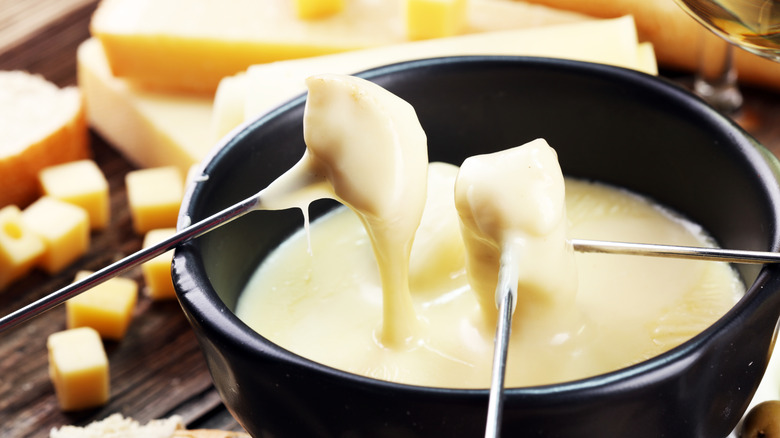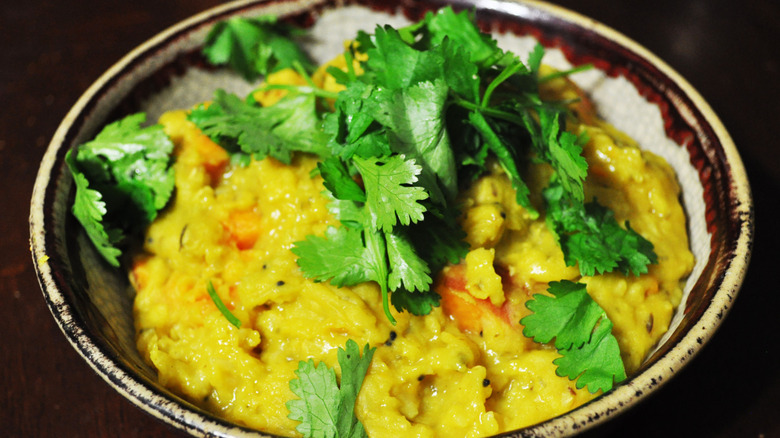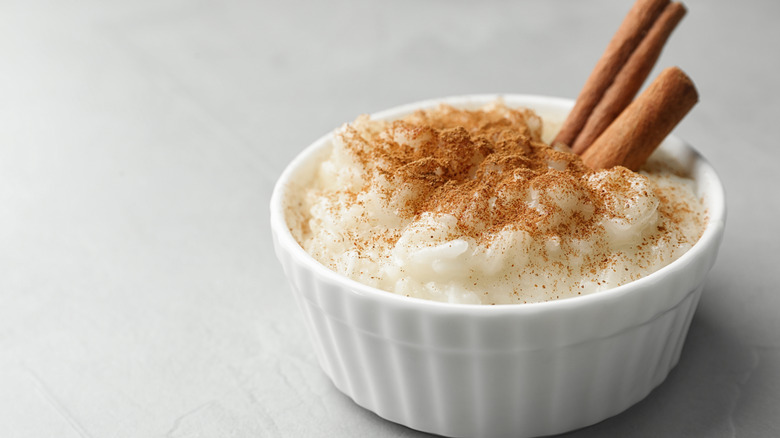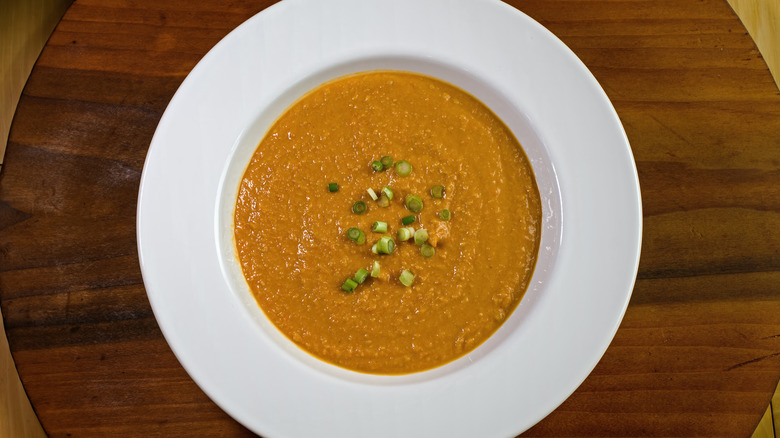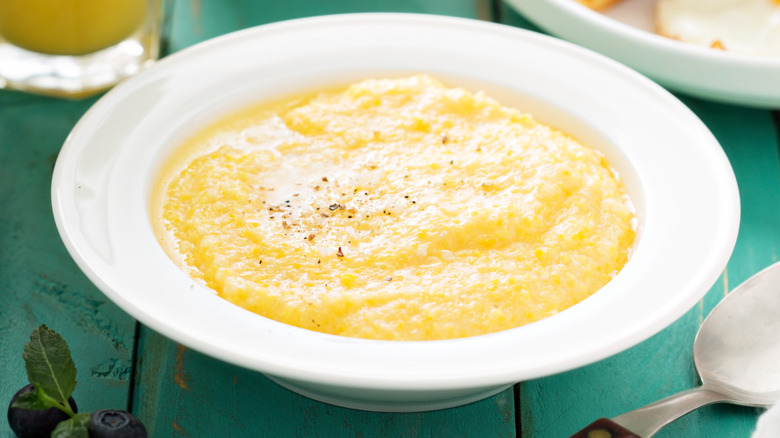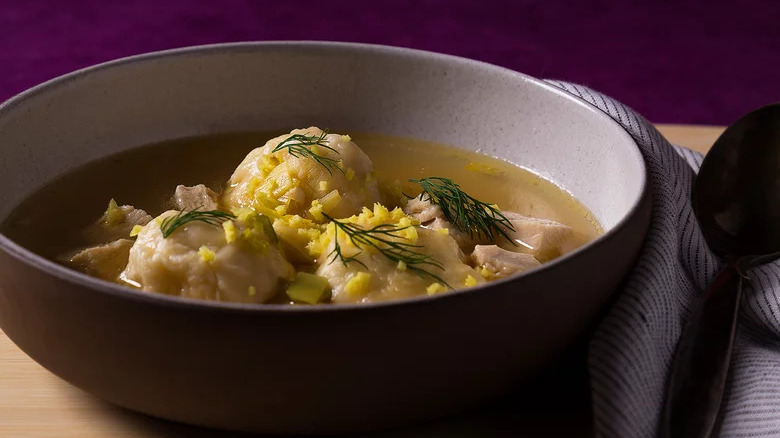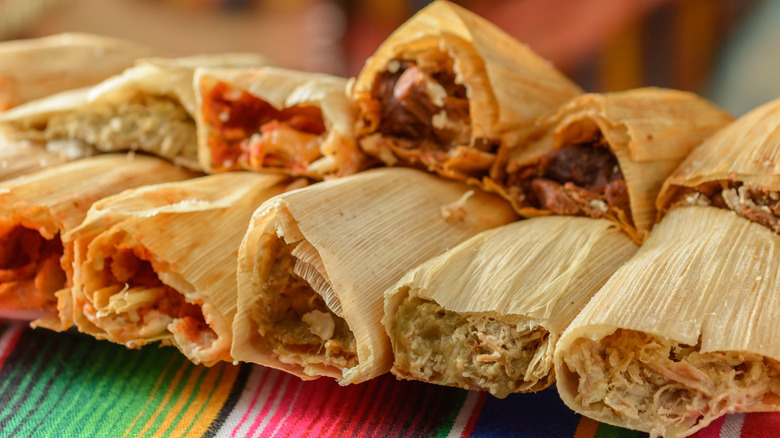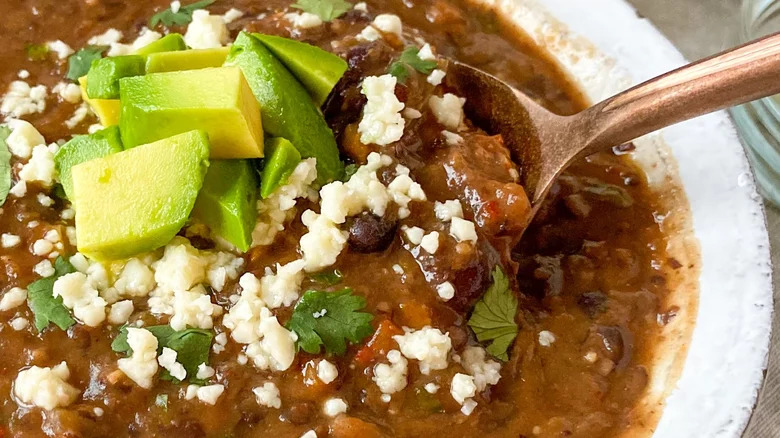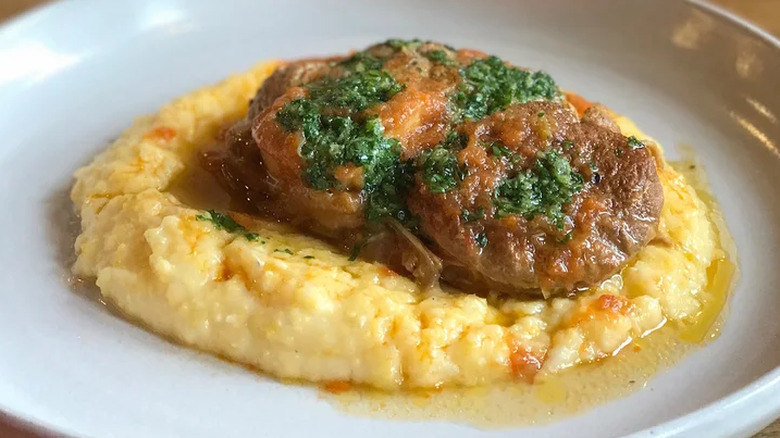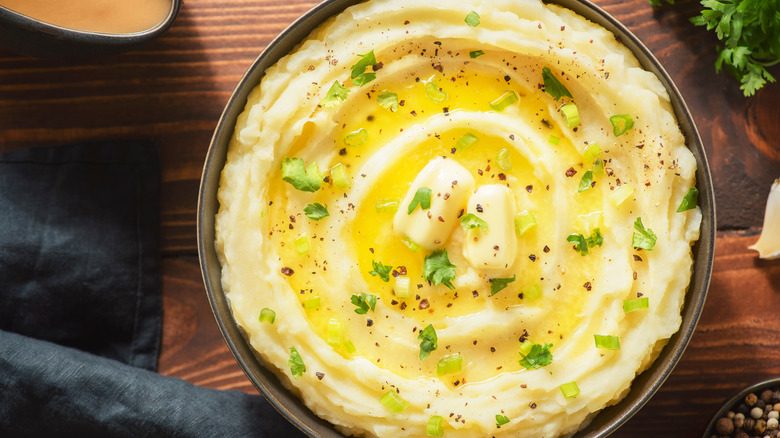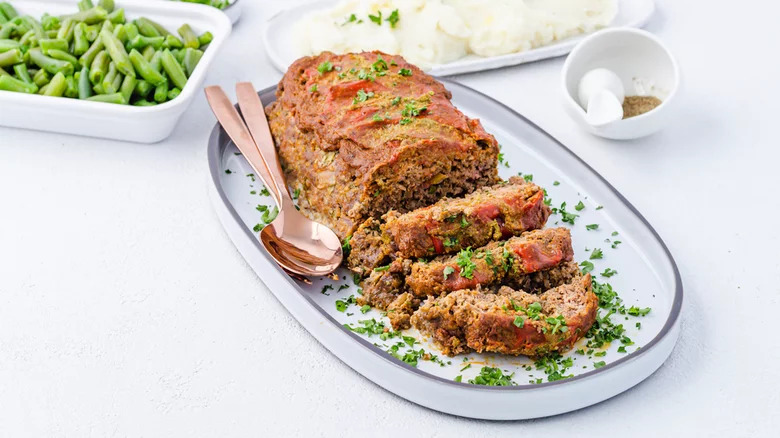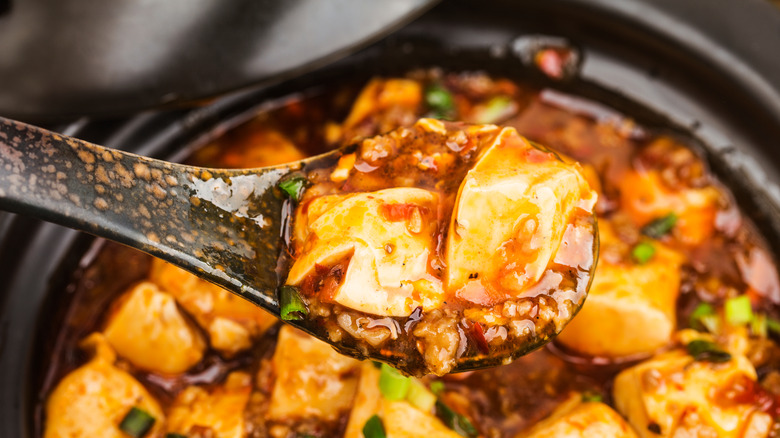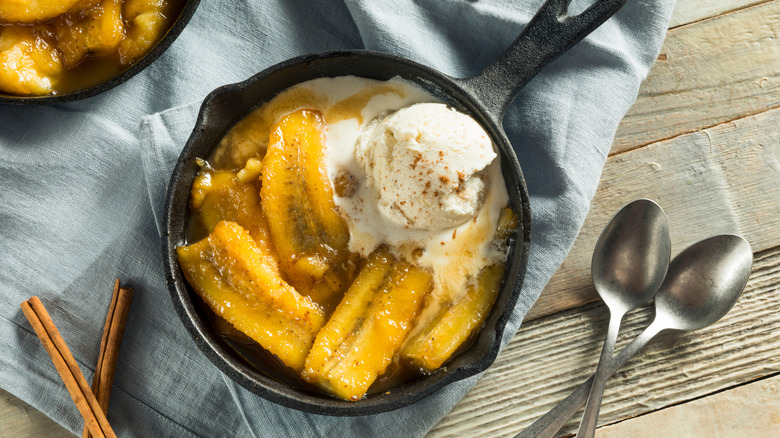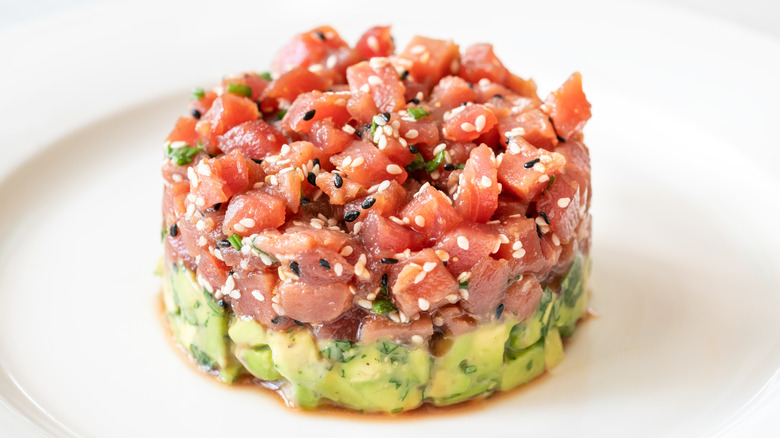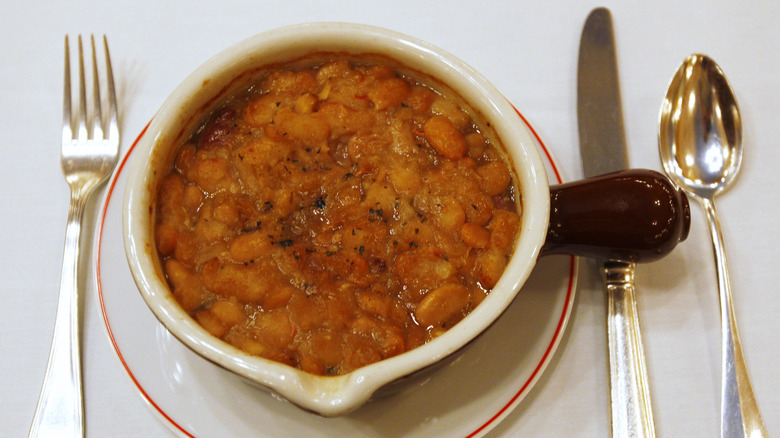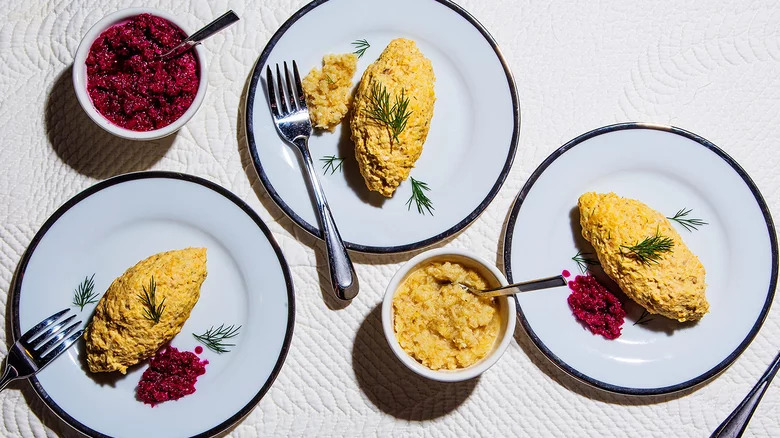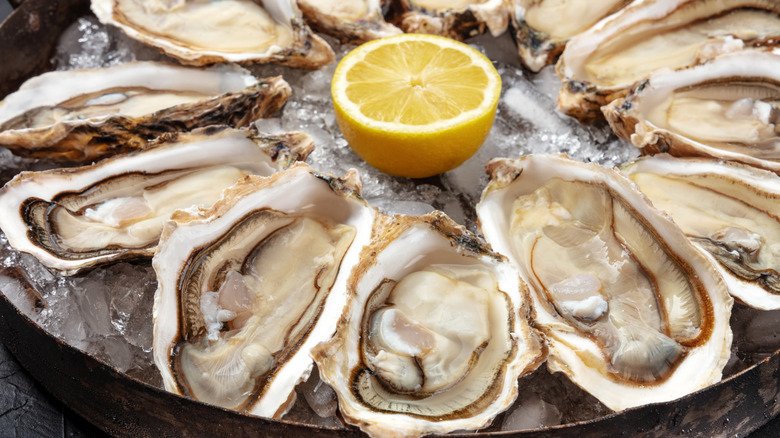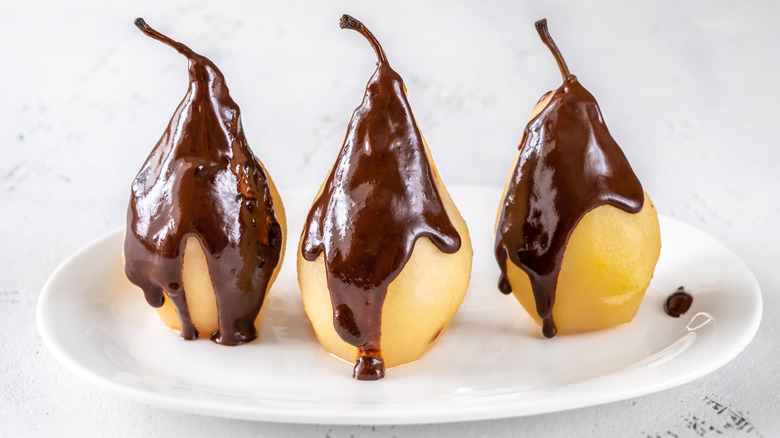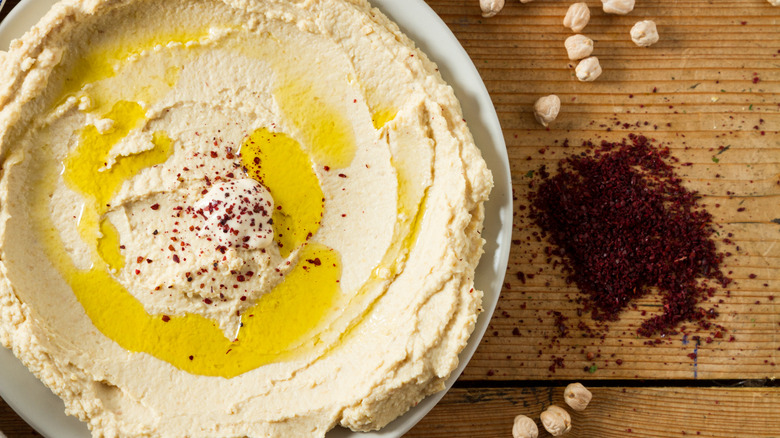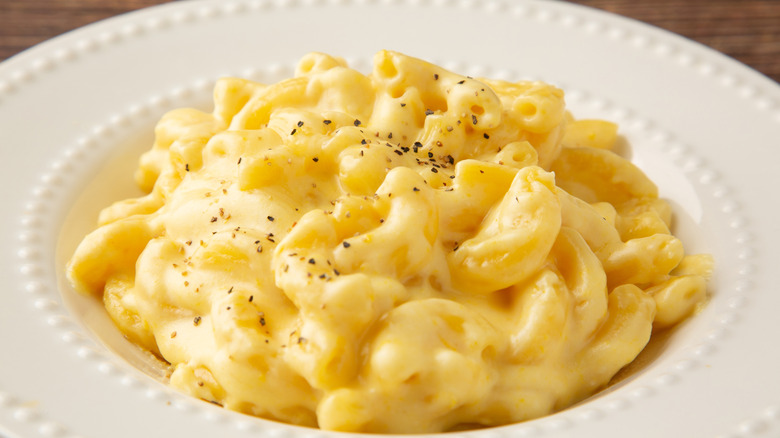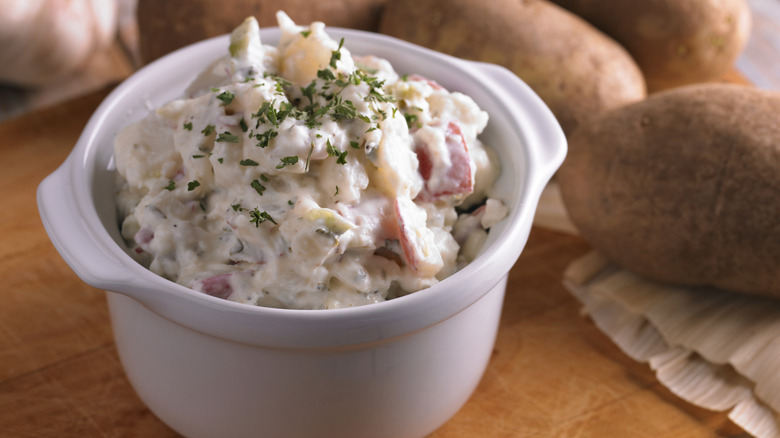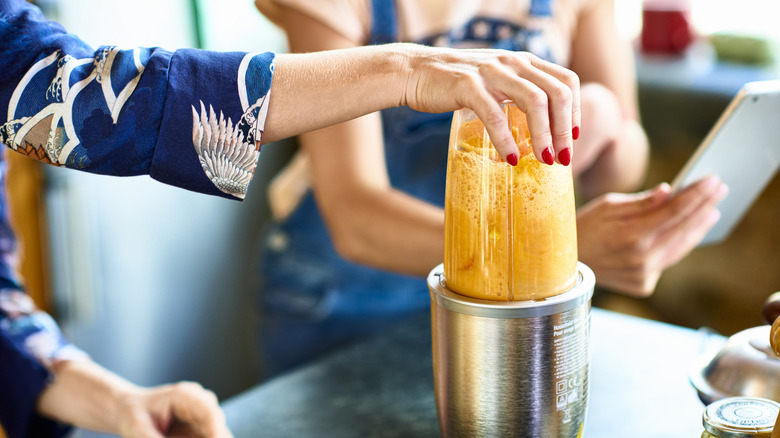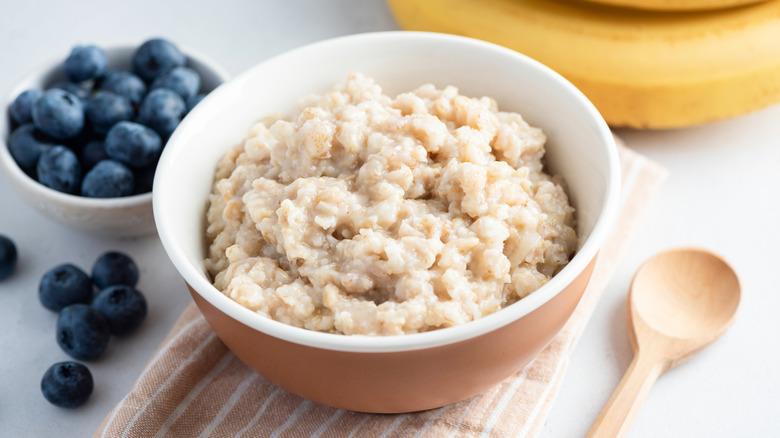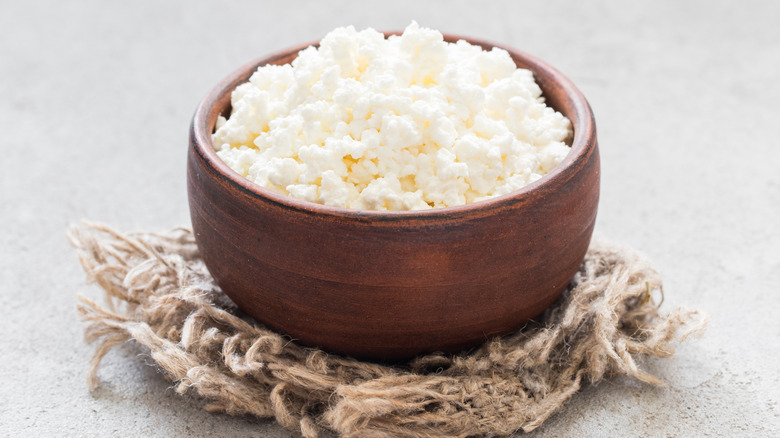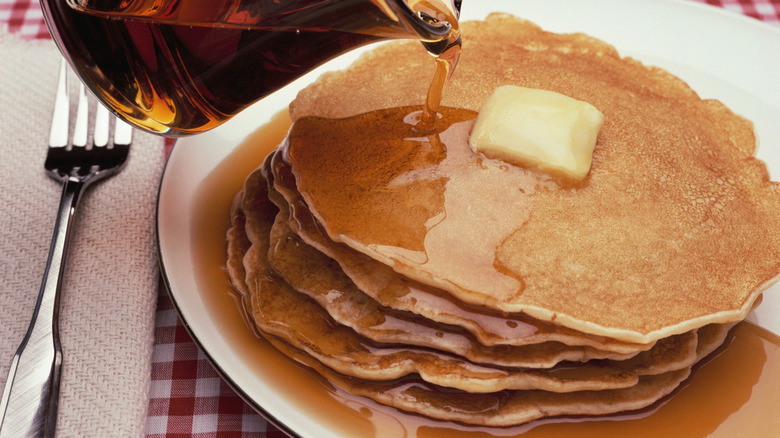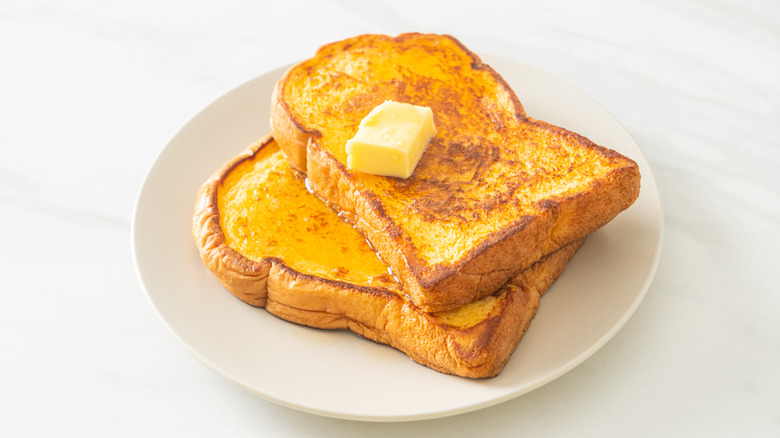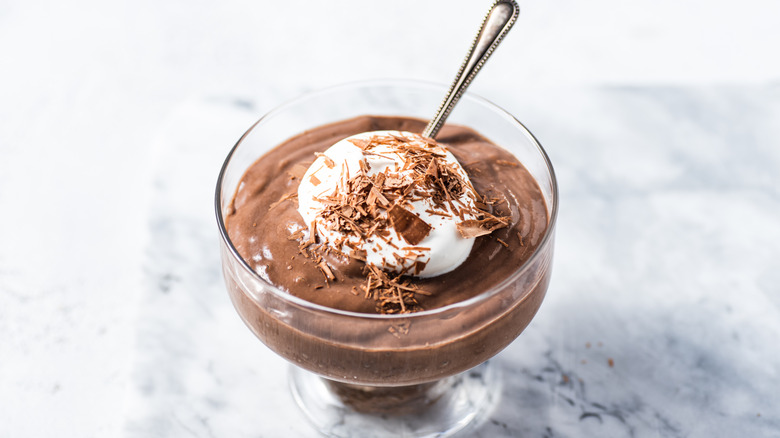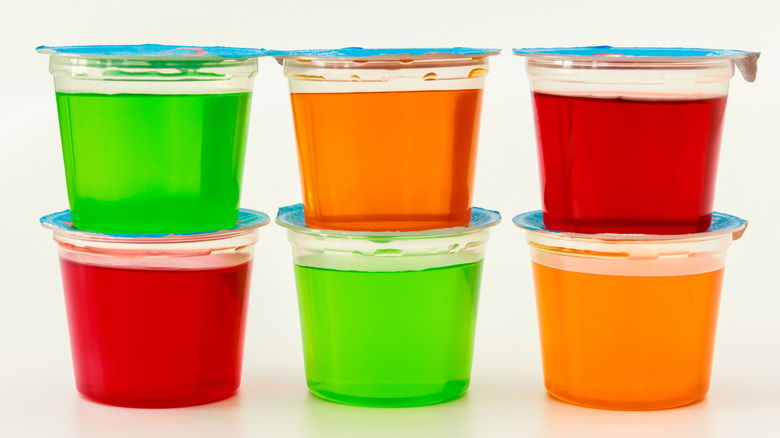34 Soft Food Ideas That Will Leave You Feeling Full And Satisfied
Crispy, crunchy, and chewy. All are words associated with toothsome eating experiences. So are dense, textured, crusty, crackling, and we could go on, but we won't for now because, at the moment, we're finding ourselves more fascinated by the possibilities that may be offered by "soft foods." Although the phrase "soft foods" tends to bring to mind bland, boring foods that are more about sustenance than actual enjoyment, we know for a fact that's not the whole story.
Certainly, there are situations that call for only the most mildly flavored and textured soft foods. Your health care professional might, for example, decide that a soft food diet is appropriate after general anesthesia, which temporarily causes the digestive tract to cease its normal activity, therefore requiring a gentle transition back to regular eating habits. And when babies are learning to eat? Doctors, of course, recommend only soft, bland foods such as bananas and cream of rice.
However, there are plenty of other circumstances that call for a soft food diet in which only the literal softness of the food is at issue. For instance, after dental surgery, you may need to stick with soft food for a while, but that soft food needn't be bland; it can be flavorful or even highly textured. And that's quite fortunate because we're about to present to you some soft food ideas that are so filling and satisfying that the fact that they are, indeed, "soft foods," seems almost beside the point.
Eggs (in every way)
Eggs are often called the "perfect protein." This is because a single large egg delivers around 6 grams of high-quality animal protein and many essential vitamins and minerals. And all of that at the caloric cost of around 70 calories. They're a complete source of protein all wrapped up into a small package.
Since there is virtually no way to prepare an egg that does not fall within the category of "soft food," eggs make soft-food eating easier than you might ever imagine. You can whip up a batch of soft and fluffy scrambled eggs within a matter of minutes, and enhance your breakfast plate with herbs and your cheese of choice. Or, try and make fool-proof poached eggs and serve it with a side of avocado for some high-quality fat. Eggs are also a great add-on for many other soft foods discussed below, including polenta, creamy grits, and mashed potatoes.
Shepherd's pie
As said, it's arguable that eggs are one of the most "efficient" forms of protein, both in terms of cost and calories. Similarly, it's reasonable to argue that shepherd's pie — a classic British pub food and family-dinner favorite — is one of the most efficient ways to consume a nutritious, savory meal in the event that you are temporarily restricted to soft foods but are still able to tolerate small pieces of soft-cooked vegetables.
One of shepherd's pie's most oft-repeated origin stories is that it was dreamed up in 18th-century Britain and/or Ireland as a way of using up leftovers. It actually makes sense when you consider that shepherd's pie is made of ground meat (traditionally lamb, but beef is fairly common, too) that's been sauteed with onions, peas, and carrots until all of it is soft, moist, and easy to chew and swallow — and then topped with a soft, salty, and creamy crust of mashed potatoes.
And if you love the idea of a stew made with meat and well-cooked veggies, but maybe not so much the mashed potato crust, then you can also consider a slow-cooked stew as a filling and satisfying soft food choice.
Matar paneer
If you're about to have dental surgery, or if you are otherwise facing some period in which your ability to chew, but not your ability to swallow or tolerate spice, may be impacted, then the north Indian dish matar paneer can be a super-comforting and uber-satisfying choice for a stick-to-your ribs meal that is anything but bland.
The Indian word "paneer" in the dish's name refers to the eponymous soft, white, mildly flavored Indian cheese that has sometimes been likened to farmer cheese because it, too, is made from milk curdled with an acid such as lemon juice or vinegar. The Indian word "matar," meanwhile, refers to peas. As the name implies, matar paneer is paneer cheese that has been cooked with peas. The sauce that typically accompanies the paneer and peas is a creamy tomato-based sauce known as tikka masala.
There are other ways to enjoy paneer in Indian cooking as well, including with a spinach-based sauce, and most of them can work in the context of a variety of soft food diets — as long as strong seasoning and capsaicin's heat are not expected to present issues.
Chili
Like matar paneer, chili is a perfect soft food choice for anyone following a soft food diet strictly because their ability to chew is temporarily impaired. Of course, we're referring only to chili made with shredded or ground meat (or meat alternative) and/or well-cooked beans, as opposed to chunks of meat. The reason is that neither ground meat (or its alternative) nor well-cooked beans require much in the way of chewing. In fact, chili essentially requires no chewing at all. You just have to be able to swallow and to tolerate a variety of seasonings.
If the softness of the food is all that is at issue, might we suggest this incredibly creamy and satisfying recipe for beef chili with pancetta, ancho, and chocolate? In fact, if that's the case, you might even want to try adding an unexpected ingredient — oatmeal — to your chili because although oatmeal won't change the chili's softness, it will add a surprising hit of texture and may even keep you full for longer. Finally, feel free to top your chili with other soft foods, including guacamole, sour cream, shredded cheese, and thin slices of green onion, and to accompany it with some nice, soft cornbread or rice.
Risotto
Even on the most restricted of soft food diets, plain white rice is almost always allowed. Risotto is a soft, gooey, starchy rice cooked with a seasoned broth, rather than plain water or even steam. But you know that already if you've ever enjoyed a plate of Parmesan risotto, one of the simplest, softest risottos imaginable and one that is both soft and fairly bland.
That being said, virtually all risottos, themselves, are soft. It's what else you mix into the risotto that will might make it fall outside the realm of "soft foods" (for example, whole shrimp or al dente-cooked broccoli). Most risottos can also be made to be rather bland, but none so easily as Parmesan risotto, which, ultimately, requires little beyond arborio rice, a flavorful broth, a bit of salt (and pepper, if it can be tolerated), and a dusting of grated cheese. And just as easily as you could top your risotto with something that takes your dish away from the "soft" realm, you can also top your risotto with a poached or fried egg for an extra hit of protein.
Cheese fondue
Many cheeses are appropriate for a soft food diet. These include blue cheeses such as gorgonzola and aged and rind-y cheese such as Camembert, both of which are soft enough to eat straight out of the refrigerator. By contrast, hard and semi-hard cheese, including Swiss cheese and raclette, needs a bit of melting if consumed by someone who has just had oral surgery or who's battling a painful tooth. It just so happens that Swiss and raclette are used frequently in making cheese fondue, which turns hard cheese into a soft foods fantasy, often with the help of a little fortified wine like cognac or brandy.
Fondue, which seems still to be enjoying a heady rise in popularity (beginning at the end of the Victorian age), is believed to date back to ancient times. In fact, it is quite possible that Homer, who authored the Greek epics the "Iliad" and the "Odyssey," may have partaken in fondue while recording his stories. And the cheese that many believe was used in Homer's fondue? Goat cheese — soft and spreadable cheese that's often used to top salads, warm vegetable dishes, and enrich some desserts.
For those wondering what soft foods can be dipped into cheese fondue, soft breads, small soft pieces of well-cooked meat, and well-cooked cauliflower seem like excellent options.
Kitchari
In this compilation of soft foods that are also filling and satisfying, we talk about matar paneer: a northern Indian dish featuring thick slices of mild white cheese smothered in a tomato sauce known as tikka masala and accompanied by perfectly mushy, well-cooked peas. We note that the dish is a great choice for anyone who's been prescribed a soft food diet for the sole purpose of healing from dental work or other oral surgery — because although matar paneer is wonderfully soft and easy to swallow, it can nevertheless be quite spicy. In other words, it wouldn't necessarily be appropriate where soft food is prescribed to deal with digestive issues.
For that, there is another classic Indian dish that many in India, in fact, turn to when they need a meal that is easy to enjoy, easy to chew and swallow, and easy to digest. It's called kitchari, which means mixture and commonly refers to a mixture of rice, mung beans (from which bean sprouts are sprouted), and soft-cooked vegetables, along with a mixture of seasonings deemed healing in the Eastern nutritional and wellness discipline Ayurveda. These seasonings may include ginger powder, mustard seeds, and/or cumin, depending on the recipe and what its stated purpose is.
Milk rice (aka rice pudding)
Having veered into the topic of Ayurveda, it doesn't seem right at this point not to mention the soft food option of rice pudding. Generally speaking, the idea of using rice to thicken milk and/or eggs into a creamy, soft dessert, snack, or even breakfast dish is ubiquitous in cultures all over the world. In fact, ordering "rice pudding" in the U.S. has been known to lead to surprising results because there is no one classic American version of the dish. Rather, people tend to default to whichever version they grew up with, and that often coincides with their family's cultural background.
German rice pudding (or milchreis), for example, tends to involve a fruit compote stir-in. Ayurvedic rice pudding, meanwhile, is meant to warm the body and stabilize the nervous system through its use of the digestive-promoting spices like cinnamon and cardamom. This version is also meant to be made with palm sugar, a sweetener known to be rich in amino acids.
The Cuban version of rice pudding arroz con leche features vanilla and cinnamon, while the Scandinavian equivalent starts by cooking the rice in a combination of milk and butter and, like the Ayurvedic version, features cinnamon and cardamom. Lastly, forbidden rice pudding, a dish commonly served for breakfast in Southeast Asia, starts with black, glutinous rice and adds in sugar and coconut milk.
Peanut soup
Just like eggs, peanut butter offers a significant bang for the nutritional buck. A single 2-tablespoon serving of peanut butter delivers 7 grams of protein (around the same as a single chicken egg) and is also a rich source of minerals (e.g., magnesium, phosphorus, and zinc), as well as vitamins such as niacin and vitamin B6.
However, at 190 calories for a single serving of peanut butter, it is significantly more nutritionally dense than a single serving of eggs. But that's not necessarily a strike against peanut butter when it comes to soft foods because it means that each mouthful delivers relatively more energy. When the food is as nutritious as peanut butter, that can be meaningful, especially when there's concern that a soft food diet might lead to loss of weight or muscle mass.
As much as peanut butter goes with jelly, it also works as a savory food, whether by the spoonful or as an ingredient in soups, stews, and chilis. It can easily be added to smoothly pureed soups for a nutritional punch — requiring no chewing, only swallowing. Not sure how to use peanut butter as a savory food ingredient? Start with this recipe for curried peanut squash soup and see what it inspires.
Grits and polenta
Both grits and polenta are porridges made from coarsely ground corn (as opposed to cornmeal, which is ground more finely). Both taste richly of corn flavor, making for a satisfying hot cereal at breakfast time. At the same time, both grits and polenta work really well as a blank canvas for other, more richly flavored foods — in much the same way that mashed potatoes, pasta, or rice can. The primary difference between grits and polenta is cultural. While Italians are the polenta masters, Southerners have laid claim to grits and made them their own. So, whereas you might see polenta served with osso bucco at an Italian bistro, you'll see grits served with creole shrimp at a Southern restaurant.
In addition, polenta is usually yellow — having been made with ground yellow corn, as opposed to the ground white corn that most grits are made from. And whereas grits are almost always served as a porridge, polenta can be served as a porridge or formed into soft cakes. Both blend well with cheese, in the same way that arborio rice does. This cheese grits recipe, for example, would work equally well if made with polenta, rather than with grits.
Dumplings
Dumplings, which are ubiquitous throughout many cultures, serve much the same purpose as grits and polenta in that they make a soft, easy-to-swallow, and satisfying side dish to accompany any number of savory, saucy dishes. However, dumplings, which are made with flour, water, and salt, tend to be softer and even easier to swallow than grits and polenta, which are made from ground corn (which is coarser than flour).
Depending on the culture, dumplings may have other ingredients as well. For example, Italian dumplings, aka gnocchi, are typically made from mashed potatoes and/or ricotta cheese, in addition to flour. German dumplings, or spaetzle, meanwhile, are smaller than gnocchi and eggier.
Chinese har gau (or har gow) dumplings are made from a mixture of wheat flour and tapioca starch and are usually formed into thin pancakes and filled with a soft, savory mixture of meats and/or vegetables. Still, other Chinese dumplings may be made with rice or rice flour, while other Asian cultures will have their own unique take and flavor, too.
The Jewish knaidel dumpling is made from matzo meal rather than flour and is almost always served in chicken soup. Southern cuisine has its own version of dumplings as well, which are typically served with a slow-cooked chicken stew, as they are in this chicken and dumplings recipe.
Tamales
Tamales, which are essentially soft cornmeal dumplings (made with masa, a type of ground corn) filled with slow-cooked shredded meat, beans, and/or vegetables and steamed while wrapped in corn husks ("tamale" comes from the Náhuatl word for wrapped), are often thought of as being in the same general Mexican food category as tacos, enchiladas, and burritos. However, the tamale has been around for a lot longer. Many historians date the tamale to the Aztec civilization — some 10,000 years ago, deducing that warriors could take them into battle and hunters could easily carry them as well.
If tamales were satisfying, energy-dense, and nutritious enough to sustain ancient warriors and hunters, then just think of how well they can do as a menu choice when you're restricted to eating only soft foods. This said, since the flavor of tamales is enhanced by the use of flavorful fats and pungent seasonings, they may not be as easy to digest as other dumpling-type foods. That being said, you can tweak the spice level of your tamale recipe to account for this.
Black bean soup
Black bean soup is another nutritionally dense soft food option. That's because its No. 1 ingredient is black beans — which is both a vegetable and a protein. And while black beans are also high in carbohydrates, eating them is not associated with the blood sugar spike that many other carbohydrates can cause. In other words, a bowlful of black bean soup is not likely to leave you hungry an hour later.
Black beans, themselves, are mildly sweet, but black bean soup tends to be rich and spicy, especially when started with sofrito, which is an "aromatic blend of vegetables, herbs, and spices" that is used as a foundation for many dishes in Hispanic cooking. Like tamales, however, black bean soup is appropriate only when spices and heat can be tolerated. In addition, black bean soup is high in fiber. While that helps to make black bean soup feel particularly satisfying, it can also make it more challenging to digest than, say, grits or polenta. If your soft food diet can tolerate a bit of heat and fiber, then you should give our recipe for spicy black bean soup a try.
Osso buco
Soft food diets should include sources of protein, which can help the body to heal after injury or surgery. When coming up with ideas for proteins to include in a soft food diet, meats may not necessarily be the first thing to come to your mind. However, a number of meats can be appropriate when one is restricted to soft foods, just as long as they are either flaky and tender to begin with (such as virtually any cooked fish) or they are cooked at a low enough temperature and for a long enough time to render them tender. A perfect example of the latter category would be osso buco, although you might not know that by its name, which is Italian for "bone with a hole."
Osso buco gets that name because it consists of a cross-cut shank or shinbone of a young calf or lamb, and it always includes a marrow bone at its center. Braised in a mixture of wine, stock, and earthy seasonings, osso buco isn't ready until it's fork tender. Then it's served either au jus or with gravy, and often perched atop polenta. Does it look like soft food? Perhaps not? And yet it is, and a satisfying, well-seasoned one at that.
Mashed potatoes
The potato easily lends itself to most soft food diets. The exception would be anything with crunchy edges such as french fries, tater tots, and the like. But we're not here to extol the virtues of crispy fried potatoes. First, they really don't need our help. More importantly, we're on about soft foods at the moment, and between baked potatoes, boiled potatoes, and mashed potatoes, there are a lot of soft food ideas to choose from. Of course, nothing can really compare to mashed potatoes when it comes to food that is both soft and comforting. When you think about it, what even are mashed potatoes except for a porridge made from potatoes, as opposed to say, ground corn, rice, or wheat?
Well, actually, mashed potatoes do contain something that some of those other porridges may not, and that is milk or cream. Unlike, say, grits, mashed potatoes require the addition of milk to the starch. And butter is kind of a prerequisite as well. Fortunately, there are many non-dairy substitutes for milk and various vegan butters that can easily pinch-hit for the relevant animal proteins. Plus, you can add flavorful add-ins to customize your mashed potatoes, or opt for a sweet potato mash instead.
Ice cream and gelato
Dessert may not have a place in the "essential" food groups, but the concept of dessert may actually be essential to humanity's survival. As food scientist Steven Witherly noted in his book "Why Humans Like Junk Food", eating something sweet at the end of a meal helps to re-energize the appetite. The reason is that, just as our sense of smell grows fatigued after prolonged exposure to any particular scent, so too does our sense of taste after prolonged exposure to any particular type of food (such as a main meal). When we transition to dessert, our appetite returns, and "we indulge in the pleasures of eating once again," he explained.
Almost any frozen dessert can work as a dessert or snack alternative when you're following a soft foods diet. But why settle for a rock-hard popsicle when you can spoon up a bowlful of ice cream or gelato? Unless, of course, you prefer popsicles. But for the rest of us, soft, creamy, melt-on-your-tongue ice cream and gelato are essentially a no-brainer on any soft food diet that doesn't restrict dairy or sugar. Of course, there are also a wide variety of non-dairy and sugar-free ice creams and gelatos to choose from, too. By way of an example, here is a vegan salted caramel ice cream that tastes creamy and delicious — and what's even better, you can make it at home.
Meatloaf
Slow-cooked meats such as Italian osso buco and American pot roast can be a highly flavorful, high-protein, calorically dense option in a wide variety of soft food diets. But not everyone has the time to spend chopping up mirepoix and braising a veal shank. Nor does everyone want to spend the kind of money it takes to purchase a veal shank. In fact, sometimes, you just gotta have the meatloaf, and luckily, if you're restricted to soft foods for any length of time, meatloaf is a perfect option. In fact, it offers pretty much everything that an osso buco or a pot roast does, only a lot faster, a lot cheaper, and a lot more comforting to a lot more people.
Moreover, meatloaf is nothing if not flexible. It can be either more or less generous with the seasonings. It can be made with almost any ground meat or combination thereof, and it can be stretched into more servings simply by mixing in breadcrumbs, eggs, and even ground vegetables. Or, try a vegan and vegetarian meatloaf made with a protein alternative like mushrooms.
Meatloaf is a natural topper for other soft foods such as its classic dinner partner, mashed potatoes. However, meatloaf (or "meat" loaf) can be equally delicious and satisfying when perched atop a bowl of cheesy grits.
Mapo tofu
Chinese food is often associated with crispy stir-fried or deep-fried meats and vegetables, and while that's certainly one way to go with Chinese food, it wouldn't be the route you'd want to take when restricted, for any length of time, to eating only soft foods. In fact, a lot of Chinese food is pretty much the opposite of what you might think of as soft food. There are plenty of exceptions, however, including various soups, fried rice dishes, and soft noodle dishes. But when it comes to soft food diet-appropriate Chinese food, it doesn't get much more tasty, filling, and nutritious than spicy bean curd, or mapo tofu.
A classic dish from the Szechuan province of China, mapo tofu is warm, filling, rich in protein, and (best of all) has an irresistibly soft consistency, which makes it the perfect Chinese dish to order when you're looking for soft (but not bland) foods.
Bananas Foster
One thing that is almost never difficult to find amid the available choices on a soft food diet is a satisfying dessert. With so many wonderful puddings and custards, ice creams and gelatos, layer cakes, cheesecakes, fruit pies, and the like, there really isn't all that much to add that you probably have not thought of already. One notable exception, however, is bananas Foster.
Bananas Foster, which can be traced back to 1950s New Orleans — when the Big Easy was a common entry point for bananas shipped up from countries in Central and South America. The dish got a lot of attention in its first decade or so of existence. However, today, it seems to have gone the way of rumaki (a tiki restaurant favorite) and quiche (which is still out there, just not as prominently as it was in the 1970s.
But it doesn't have to be so. And if you love the idea of ripe bananas, cooked even softer in caramel syrup and served with a scoop of vanilla ice cream, then you can have bananas Foster anytime you want, so long as you're willing to make it yourself and have a banana or two on hand, plus some sugar and butter in your kitchen. Even better if you happen to have a few other items at the ready, including rum and a blow torch, then we've got the perfect bananas Foster recipe you need right this very minute.
Steak tartare and tuna tartare
Steak tartare, which belongs as much to ancient Mongolia as it does to French bistros of the 1980s, traditionally referred to a finely chopped (sometimes even pureed) raw beef, seasoned with salt and pepper, Worcestershire sauce, mustard or tabasco, and slathered in egg yolk for a rich, smooth consistency. However, midway through the 1980s, chef Shigefumi Tachibe began experimenting with substituting high-quality raw tuna in place of the beef. What Tachibe came up with was a combination of finely diced tuna tossed in a dressing of egg yolks, olive oil, and mustard (almost like a deconstructed aioli sauce) and accessorized with diced avocado, peppercorns, capers, chives, and tarragon.
Whether beef, tuna, salmon, or something else entirely, tartare makes a perfect soft food meal or appetizer that's high in protein and long on taste. And many people find it visually pleasing as well.
Cassoulet
French cassoulet, a classic stew from the Languedoc province, has been called the ultimate in French comfort food. Originally considered a peasant food, any given cassoulet consisted of whatever meats, beans, vegetables, and seasoning were both available and appropriate for being stewed all together in a pot, low and slow, for hours or even days at a time.
A typical modern-day cassoulet tends to include several key ingredients, including white beans cooked to be soft but not mushy, preserved duck (usually poached in oil at a temperature low enough that you're not deep-frying the meat, but rather cooking it slowly so that the flesh breaks down and becomes meltingly tender), and sausage. However, there's a great deal of flexibility in terms of ingredients and presentation.
If you're planning on including cassoulet in your soft food eating plan, you'll want to make sure that everything in it is cooked softly enough to be swallowed easily. Additionally, some of the individual pieces of meat and vegetables may need to be cut into smaller pieces before being consumed.
Gefilte fish with horseradish
Gefilte fish is to whitefish, pike, and carp what meatballs are to beef, pork, and veal. In other words, just as meatballs are made from ground meats, raw eggs, breadcrumbs, and various seasonings and then cooked through in a simmering sauce, gefilte fish are small savory "cakes" made from ground white fishes mixed with ground onions, carrots, raw eggs, matzo meal, and various seasonings and then poached in a flavorful, savory liquid before being refrigerated and served cold with spicy chopped horseradish.
Making gefilte fish is not really any more difficult than making meatballs, although you may not be accustomed to working with ground fish, so there may be a brief learning curve. If you're up for it, we have a really fantastic recipe for a version that uses salmon and halibut rather than the typical white fish. However, wonderful ready-made gefilte fish is also available in jars at the supermarket by such brands as Manischewitz and Mrs. Adlers.
Oysters on the half shell
Slurping raw oysters with cocktail sauce may not sound particularly urbane on paper. But in real life, it can feel surprisingly sophisticated, and more importantly, for our purposes, it requires virtually no chewing action at all, making oysters on the half shell a surprisingly elegant option for those on soft foods — as long as consuming raw foods doesn't present a problem. If you've never tried oysters on the half shell, you'll want your first time to be in a restaurant, where all of the hard work, including the tricky process of shucking, will be done before you ever see the oysters.
After that, it's just a matter of squeezing a bit of lemon on the exposed oyster, taking your fork (usually a tiny little fork meant specifically for the eating of shellfish) and using it to move the oyster around a bit in the shell so that it comes fully loose from the shell. Then put down the fork, and using your thumb and forefinger, pick up the shell from the narrowest side, lift it to your mouth, and slurp the oyster into your mouth, and swallow. If you like cocktail sauce, which many do with their oysters, spoon a small dab onto your oyster in between putting down your fork, and pick up the oyster with your fingers.
Poire belle hélène
Many desserts are soft enough to enjoy comfortably while on a soft food diet, but one in particular, the classic Parisian dessert poire belle Hélène can elevate soft food eating to another level entirely. Poire belle Hélène consists of peeled ripe pears poached in a sweet, vanilla-scented syrup — one that is often spiked with a pear-flavored brandy — until meltingly soft all the way through and then served with a dark chocolate sauce and vanilla ice cream.
The poire belle Hélène gets its name from the Jacques Offenbach opera, "La Belle Hélène," which opened in Paris in 1864. As the story goes, legendary French chef Auguste Escoffier was in attendance at that first performance, and he was so impressed that he felt inspired to come up with a recipe to honor the opera. Poire belle Hélène is often served with sliced, toasted almonds, but that's hardly the biggest draw. Rather, it's the tenderness of the fruit and the way the fruit's flesh takes on the layered flavors of the poaching syrup.
Hummus
Hummus is a Middle Eastern dish consisting of mashed chickpeas (aka garbanzo beans), garlic, lemon, and tahini sauce (which is made from sesame seeds) and sometimes a swirl of extra virgin olive oil. Healthy, wholesome, and rich in protein, minerals, fiber, and vitamin B, hummus can be used as a savory dip for such crispy nibbles as fresh, raw vegetables, pretzels, and pita chips. However, if you've just gone through dental surgery, or, if for any other reason, you're not in a position to chew, then you'll need to be a bit more creative when it comes to finding ways to enjoy creamy hummus. Or you could just keep reading because we know lots of ways to enjoy hummus that are consistent with a soft food diet.
For example, instead of dipping pita chips or baby carrots into hummus, you can try tearing off small pieces of fresh, fluffy pita bread. Or you could spread the hummus on a piece of soft white bread, and enjoy it as a sandwich, whether closed or open-faced. Additionally, you could give eating hummus with a spoon a try — especially if you already enjoy eating peanut butter straight from the jar.
Macaroni and cheese
We would be remiss if we didn't mention one of the most nostalgic soft foods of them all: macaroni and cheese. Not only is this pasta dish easy to whip up as long as you have noodles, your favorite cheese, and a splash of milk or cream handy, but you can also easily customize your mac and cheese with tasty additions including shredded chicken, bacon, and breadcrumbs. These additions will add some extra texture and flavor to your crock of pasta, but not pull it out of soft food territory. Alternatively, you can make your mac and cheese recipe a bit more vegetable-forward by whipping up a butternut squash mac and cheese. When blended, you may not even notice the difference between this especially orange pasta and a more classic mac and cheese recipe.
You don't even have to have a range of ingredients handy to whip up a homemade batch. When all else fails, turn to a beloved instant mac and cheese brand to have a meal on the table within minutes. Granted, not all of these boxed mac and cheeses are created equal, so you may have to resort to your spice cabinet or hot sauce collection to give your pasta some oomph.
Potato and pasta salad
If you're adhering to a soft food diet, you may still be able to find options at your family cookout. Besides the mac and cheese and ice cream sandwiches, you can grab a couple of spoonfuls of potato or pasta salad to adorn your plate. These salads are typically mayonnaise-based, so you can rest assured that they will go down easy and provide you with a wholesome, filling side (or main). You will have to express some caution when it comes to eating, though. Some salads contain chunks of celery or crunchy veggies that don't go down as easily as the pasta or potatoes themselves, so you're always best off asking what's in the salad first before you pile it high on your plate.
Although pasta and potato salads tend to be very carb-based, you can add some extra ingredients to boost up the protein content so that you stay fuller for longer. A chicken macaroni salad, for example, will give you a hearty boost of flavor and can be easily adapted to remove harder ingredients, like cherry tomatoes. If you love the flavor of bacon, you'd also enjoy our bacon and egg ranch potato salad recipe made with hard-boiled eggs and bacon cooked to your liking.
Shakes and smoothies
Smoothies are a great way to refuel after a particularly grueling workout, but there's no wrong time to drink one (or a shake). Plus, these soft foods are incredibly versatile. You can essentially shove any fruit or vegetable into a blender with a little bit of liquid, hit the blend button, and it will all turn out fine. If you're after something fruity, try your hand at a refreshing smoothie recipe made with strawberries, bananas, raspberries, and the like. You can also add some vegetables, like kale or spinach, for some extra fiber and micronutrients.
When making a smoothie at home, it's important to incorporate healthy fats as well as protein, especially if you're using these beverages as a meal replacement or an alternative to solid food. Protein powder can be an easy way to add an extra boost to your smoothie and help keep you satiated for longer. Fats will also aid in satiety; add some pieces of avocado for a smooth, creamy smoothie with a neutral flavor.
Of course, you don't have to make your own smoothie at home. If you take a walk down the health foods aisle at your grocery store, you'll find an array of shelf-stable meal replacement shakes. These shakes are super convenient to sip on, and it's relatively easy to find one that matches your nutritional goals — whether that's high-protein, keto-friendly, or dairy-free.
Oatmeal
We're big, big fans of oatmeal here at Tasting Table — and for good reason. The versatile food can be prepared in so many different ways. You can always go with a traditional preparation on the stovetop, which will lead to soft and fluffy oats that are just begging to be drizzled with maple syrup or topped with fruit. You can also cook oatmeal in the microwave for a hearty, fiber-packed breakfast that's ready in a matter of minutes.
Now, if you don't like the sensation of biting into warm oatmeal's porridge-like consistency, try your hand at overnight oats. You simply need to combine dry, old fashioned oats with your milk of choice — dairy or non-dairy — and let them sit in the refrigerator overnight. The oats will soak up all that liquid, leaving you with a delectably soft breakfast that's easy to eat on-the-go. We like incorporating an extra dose of protein powder to our oatmeal to help supplement the carbs in it, but you can add nut butters, sweeteners, or a scoop of Greek yogurt to yours if preferred.
Another way to prep oatmeal for meals is to bake it. Our recipe for peanut butter and roasted banana baked oatmeal is super easy to prep for the week ahead. This recipe yields many portable squares, which you can pack into a kid's lunchbox or take to work for a quick and easy breakfast.
High-protein dairy products
High-protein dairy products are a wide class of foods — all of which can help you meet your nutritional goals if you're on a soft food diet. One of the most obvious ones is Greek yogurt, which can be mixed or served with numerous breakfast foods to add a punch of protein and healthy fats. Add a spoonful into your favorite smoothie recipe to make it extra creamy, or serve it in a bowl with some mashed banana. You can even use Greek yogurt as a replacement for sour cream in dips, as it boasts a similar sourness (but more protein).
As you build your library of the best soft foods to add to your diet, you may also discover the overall value of cottage cheese. This soft cheese can be used in an array of dishes for an extra dose of protein and creaminess. It's the secret ingredient to the creamiest scrambled eggs you've ever had, while the added protein will help keep you fuller for longer.
You can also resort to drinkable dairy products to help you meet your nutritional goals. Dairy kefir (which is not the same as water kefir) is a fermented dairy product that contains protein, calcium, and some essential vitamins. You'll find it stocked in the refrigerated section of the grocery store, likely alongside yogurts. While it's a bit of an acquired taste, it does offer an easy-to-drink option with tons of micronutrients.
Pancakes
No trip to a diner is complete without a short stack of pancakes. This timeless breakfast food is a classic for a reason, and it might have something to do with the way pancakes soak up syrup like a sponge. Considering the sheer number of different pancake mixes available at the grocery store, there's no shortage of options and ways to make your own at home. And while pancakes tend to be a very carb-heavy breakfast food, there are tons of ways to make them more nutritious — all while still using soft ingredients.
For one, you can swap out the sugary syrup for something else, like nut butter, ricotta cheese, or Greek yogurt. You may also consider using a protein-rich pancake mix, like one from Kodiak Cakes, to get a more nutrient-dense breakfast with all the familiar flavors you love.
Of course, while there's no wrong way to eat pancakes, there's certainly a right way to make them. Regardless of what kind of pancake mix you use (or if you make your own), you'll want to brush up on some of the top tips for making great pancakes. Be sure to avoid mixing your batter too much, for instance, as this can make it stodgy, and turn your pancakes into hockey pucks. You can also add a tangy ingredient like sour cream or buttermilk to lighten the batter and improve the flavor.
French toast
Some people may believe pancakes share the breakfast throne with another popular selection: French toast. Preparing a batch for a quiet Sunday brunch or a weekday breakfast is a great way to use up leftover stale bread, turning it into something tasty in the process. The basic recipe for French toast involves placing the bread into a custard made with eggs and a splash of milk, then cooking it on both sides until it's golden brown. Of course, there are tons of variations to consider if you're looking for a delicious soft food.
While most preparations lean sweet (thanks to the help of ingredients like cinnamon, vanilla extract, and maple syrup), you may want to try a savory rendition for your next breakfast-for-dinner meal. To do this, add a coating of your favorite cheese or some herbs to the batter; thyme and rosemary are a great place to start. Top your stack with whatever suits your fancy, whether that's a drizzle of maple syrup or some shaved Parmesan cheese to lean into the savory side.
Regardless of how you prepare it, there are some cardinal rules you'll want to follow to ensure your French toast comes out perfect. Try to leave your bread out overnight to ensure it's dry enough to soak up all the custard. You can also cook it in butter or leftover bacon grease to improve the flavor, though be sure to grease the pan well to stave off stickiness and ensure your slices cook properly.
Pudding
Pudding may seem like a food from decades past, but we think it deserves a resurgence. It's an excellent sweet treat for anyone on a soft food diet, such as the elderly or people who've undergone bariatric surgery. Some folks opt to make their own puddings, though there's an array of easy to use store-bought pudding options to use when you're craving something sweet. From decadent chocolate to fruity selections, there's likely something for you in the pudding aisle.
There are other types of puddings that might be worth looking at as well. Rice and tapioca pudding (which some may remember as a childhood dessert) used to be quite popular, thanks to their low-cost ingredients and simple preparation. If you're seeking a blast-from-the-past with a sweet flavor to go with it, try making a batch for yourself with the help of store-bought tapioca, or whip up a homemade rice pudding.
Another dish under the pudding umbrella that packs a little bit less of a sweet, sugary punch is avocado mousse. If you're adhering to a plant-based diet, it's certainly a dessert worth trying. Blend together the fruit with a little bit of cocoa powder, oil, maple syrup, and water until it reaches your desired consistency. You'll get a healthy dose of potassium and fat from the fruit, and have greater control over how much sugar is in it compared to a store-bought mix.
Gelatin-based desserts
Gelatin-based desserts are another sweet treat worth making if you're adhering to a soft food diet. There's no shortage of different gelatin flavors available at your local grocery store, including orange, lime, strawberry, and raspberry (among others). You may even be able to track down zero-sugar options at your local grocer in the form of a powdered mix or pre-made cups.
While gelatin is a relatively straightforward ingredient to work with, there are some important things to know before using it. For one, some tropical fruits, including pineapple, contain enzymes that inhibit gelatin from setting, so you may want to avoid using them. You'll also want to be careful of temperatures, as cooking gelatin too hot may prevent it from setting. Additionally, there's nothing wrong with taking the old-fashioned diner approach, and serving a bowl of Jell-O topped with a little bit of whipped cream. But you can also make an array of desserts using gelatin as the base.
One popular option that's as different from neon-colored Jell-O cups as possible is panna cotta. This dessert is made by combining milk with heavy cream, sugar, and gelatin (either sheets or powdered). Once the panna cotta base is made, it needs to be set — undisturbed — in ramekins to allow the gelatin to set and the dessert to take shape. This very classy (and soft) dessert is worthy of a spot on your dessert table, whether for a fancy dinner party or a cozy night in.
